Introduction
In agriculture, the rice mill business is a crucial link in the production chain, transforming raw paddy into the staple we consume daily—rice. For entrepreneurs venturing into this domain, choosing equipment and machinery becomes a defining factor influencing productivity, quality, and overall operational efficiency. This article is a comprehensive guide to the essential equipment needed for a thriving rice mill business, emphasizing the significance of modern technology in streamlining operations.
1. Paddy Cleaning Equipment
De-stoner Machines:
The journey to a successful rice mill business commences with thorough paddy cleaning. De-stoner machines, a cornerstone in this process, efficiently remove stones and heavy impurities from the paddy. This not only prevents damage to subsequent machinery but also elevates the quality of the final rice product.
Paddy Husker:
Integral to the initial milling stages, a high-quality paddy husker is vital in removing husks from the paddy. This prepares the paddy for the subsequent milling process, ensuring a smoother workflow.
2. Rice Milling Machines
Whitening Machines:
Investing in advanced rice milling machines is paramount for achieving optimal yield and quality. Whitening machines, equipped with innovative features, remove remaining bran layers, enhancing the appearance and quality of the rice. Advanced whitening machines offer precise control over milling, ensuring uniform and high-quality rice grains.
Polishing Machines:
Polishing is a critical step in improving the market appeal of rice. Polishing machines contribute to the glossy finish of the rice, enhancing its appearance and removing any remaining bran particles. This step adds to the visual appeal and ensures a refined final product.
Grading Machines:
Grading machines categorize rice based on size, shape, and quality. This step ensures that the final product meets market standards, allowing for better pricing and heightened customer satisfaction. Efficient grading is key to establishing a competitive edge in the rice milling business.
3. Drying Equipment
Batch Dryers:
Proper drying is imperative to prevent mold growth and maintain the quality of the rice. Using heated air, batch dryers remove moisture from the rice in batches. These are suitable for smaller-scale operations, providing drying time and temperature control flexibility.
Continuous Flow Dryers:
For larger rice mills, continuous-flow dryers offer an automated and continuous drying process. They are energy-efficient and provide precise control over temperature and airflow, ensuring uniform drying and preserving the nutritional integrity of the rice.
4. Packaging Machinery
Automatic Bagging Machines:
Once the rice has been milled and dried, proper packaging is crucial for preserving its quality. Automatic bagging machines streamline the packaging process by automatically weighing and filling bags with the desired quantity of rice. This enhances efficiency and reduces the likelihood of human errors in the packaging stage.
Sealing Machines:
Sealing machines play a vital role in ensuring the freshness and longevity of the rice. They effectively seal bags, preventing the entry of moisture and contaminants. This step is critical for maintaining the quality of the rice during transportation and storage.
5. Storage Silos
Investing in proper storage facilities is crucial for maintaining the quality of the rice post-milling. Storage silos provide a controlled environment that protects the rice from environmental factors and pests.
Airtight Design:
Airtight silo designs prevent the entry of moisture and pests, preserving the quality of the stored rice. This is a critical consideration to ensure that the rice remains in optimal condition until it reaches the end consumer.
Temperature Control:
Silos equipped with temperature control features help prevent the development of mold and maintain the nutritional integrity of the rice. Temperature control is especially important for long-term storage, ensuring the rice retains its quality over an extended period.
Conclusion
In conclusion, the success of a rice mill business is intricately tied to the strategic selection of equipment and machinery. From the initial cleaning stages to the final packaging and storage, each step demands a careful choice of technology to optimize efficiency and product quality.
As technology advances, staying updated with the latest innovations in rice milling equipment becomes imperative for sustainable growth and success in the ever-evolving rice industry. By making informed choices in equipment and machinery, entrepreneurs can enhance the efficiency of their rice milling operations and contribute to the overall growth and sustainability of the rice milling industry.
As the demand for high-quality rice continues to rise globally, investing in the right technology becomes a strategic move towards establishing a thriving rice mill business. The incorporation of advanced machinery not only streamlines operations but also positions the rice mill as a competitive player in the market, ready to meet the evolving needs of consumers.
 MAIL US :
MAIL US :
 CALL US :
>
CALL US :
>
